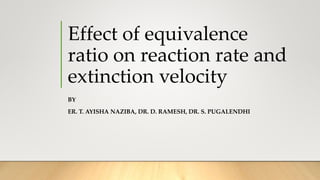Effect of equivalence ratio on reaction rate and extinction velocity
•
0 likes•2 views
The equivalence ratio plays a critical role in influencing the reaction rate and extinction velocity in combustion processes. Understanding these effects helps optimize combustion conditions for efficient and stable operation while minimizing emissions and combustion instabilities. Balancing the equivalence ratio is essential to achieve optimal combustion performance and meet environmental and operational requirements.
Report
Share
Report
Share
Download to read offline

Recommended
Recommended
More Related Content
More from Ayisha586983
More from Ayisha586983 (20)
Coal gasification - characteristics & factors affecting

Coal gasification - characteristics & factors affecting
Gasifier types - Fixed and Fluidized bed gasification

Gasifier types - Fixed and Fluidized bed gasification
Submerged Combustion, Explosion Flame Combustion, Pulsating Combustion, and E...

Submerged Combustion, Explosion Flame Combustion, Pulsating Combustion, and E...
Combustion phenomena in diesel and gasoline engines

Combustion phenomena in diesel and gasoline engines
Pulverized fuel combustion - Fluidized bed combustion

Pulverized fuel combustion - Fluidized bed combustion
Combustion of liquid fuels and its principles.pptx

Combustion of liquid fuels and its principles.pptx
Combustion behaviour in Internal Combustion engines.ppt

Combustion behaviour in Internal Combustion engines.ppt
Recently uploaded
Recently uploaded (20)
Linux Systems Programming: Inter Process Communication (IPC) using Pipes

Linux Systems Programming: Inter Process Communication (IPC) using Pipes
PE 459 LECTURE 2- natural gas basic concepts and properties

PE 459 LECTURE 2- natural gas basic concepts and properties
Double Revolving field theory-how the rotor develops torque

Double Revolving field theory-how the rotor develops torque
Basic Electronics for diploma students as per technical education Kerala Syll...

Basic Electronics for diploma students as per technical education Kerala Syll...
Max. shear stress theory-Maximum Shear Stress Theory Maximum Distortional ...

Max. shear stress theory-Maximum Shear Stress Theory Maximum Distortional ...
DC MACHINE-Motoring and generation, Armature circuit equation

DC MACHINE-Motoring and generation, Armature circuit equation
Theory of Time 2024 (Universal Theory for Everything)

Theory of Time 2024 (Universal Theory for Everything)
💚Trustworthy Call Girls Pune Call Girls Service Just Call 🍑👄6378878445 🍑👄 Top...

💚Trustworthy Call Girls Pune Call Girls Service Just Call 🍑👄6378878445 🍑👄 Top...
Effect of equivalence ratio on reaction rate and extinction velocity
- 1. Effect of equivalence ratio on reaction rate and extinction velocity BY ER. T. AYISHA NAZIBA, DR. D. RAMESH, DR. S. PUGALENDHI
- 2. Equivalence ratio • The equivalence ratio (ϕ) in combustion is a key parameter that describes the ratio of actual fuel-to-air ratio to the stoichiometric fuel-to-air ratio required for complete combustion. The effect of equivalence ratio on reaction rate and extinction velocity in combustion processes is significant • 𝜙 = 𝑆𝑡𝑜𝑖𝑐ℎ𝑖𝑜𝑚𝑒𝑡𝑟𝑖𝑐 𝐹𝑢𝑒𝑙−𝑡𝑜−𝐴𝑖𝑟 𝑅𝑎𝑡𝑖𝑜 𝐴𝑐𝑡𝑢𝑎𝑙 𝐹𝑢𝑒𝑙−𝑡𝑜−𝐴𝑖𝑟 𝑅𝑎𝑡𝑖𝑜 •
- 3. Effect of Equivalence Ratio on Reaction Rate: • Generally, the reaction rate increases with increasing equivalence ratio up to a certain point (slightly rich conditions). • Beyond this point, the reaction rate decreases due to lack of sufficient oxidizer (oxygen) for complete combustion. • Stoichiometric Condition (ϕ=1): • At ϕ=1, the mixture is exactly at the stoichiometric condition where all the fuel and oxygen are consumed completely.
- 4. • Lean Mixture (ϕ<1): • For ϕ<1 (lean mixture), there is an excess of air compared to the stoichiometric requirement. • In lean mixtures, the reaction rate tends to decrease because of insufficient fuel for complete combustion. • The slower reaction rate in lean mixtures is due to reduced fuel availability, resulting in longer ignition delays and incomplete combustion.
- 5. • Rich Mixture (ϕ>1): • For ϕ>1 (rich mixture), there is an excess of fuel compared to the stoichiometric requirement. • In rich mixtures, the reaction rate can increase initially due to the availability of excess fuel. • However, excessively rich mixtures can lead to inefficient combustion, increased emissions, and potential carbon monoxide (CO) formation.
- 6. Effect of Equivalence Ratio on Extinction Velocity • Extinction velocity (Sext) is the minimum flow velocity of a reactant mixture at which the flame can be sustained. • Extinction velocity generally varies inversely with equivalence ratio. • As equivalence ratio increases (leaner mixtures), the extinction velocity increases due to higher oxygen demand for combustion. • Conversely, as equivalence ratio decreases (richer mixtures), the extinction velocity decreases because less oxygen is required to sustain combustion.
- 7. • Lean Mixtures (ϕ<1): • In lean mixtures (ϕ<1), the extinction velocity tends to be higher. • This is because lean mixtures require higher air (oxygen) flow rates to sustain combustion and prevent flame extinguishment.
- 8. • Rich Mixtures (ϕ>1): • In rich mixtures (ϕ>1), the extinction velocity tends to be lower. • Excess fuel in rich mixtures can sustain combustion even at lower air flow rates, reducing the extinction velocity.
- 9. THANK YOU